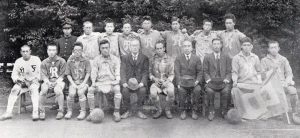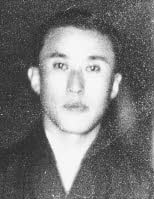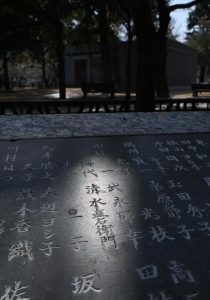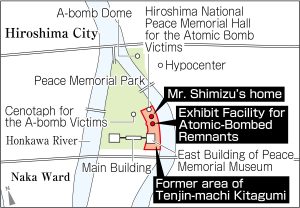Striving to fill voids in Hiroshima, evidence of victims remains—Naoemon Shimizu, legendary soccer player on Japan national team, dies under hypocenter in former Tenjin-machi Kitagumi short of life goals
Mar. 19, 2022
Scored Japan national team’s second goal in history
Family implores “Don’t repeat war”
by Kyosuke Mizukawa, Senior Staff Writer
On August 6, 1945, when the U.S. military dropped an atomic bomb on Hiroshima, a former member of the Japan national soccer team was killed in the former Tenjin-machi Kitagumi, an area that now lies within the present-day Hiroshima Peace Memorial Park, in the city’s Naka Ward. Naoemon Shimizu, a member of the powerful soccer (or, football) team of the former First Hiroshima Prefectural Junior High School (now Kokutaiji High School, in Naka Ward), scored the second goal in the history of the Japan national soccer team at an international match held in Japan’s Taisho Era (1912-1926). Ahead of the March 26 opening of the Exhibit Facility for Atomic-Bombed Remnants, located near the site where Mr. Shimizu’s home once stood, the Chugoku Shimbun traced the life of the soccer great, who is now known by only a handful of people in Hiroshima.
Reiko Shimizu, 79, Mr. Shimizu’s niece who lives in Hiroshima’s Higashi Ward, said, “I was told that my uncle was an exceptionally athletic and good-looking man who was relied on by everyone in his family.” Ms. Shimizu continues to display a photograph of her uncle at her home as a memorial to him. He died in the atomic bombing when she was two years old. Mr. Shimizu’s mother, the younger sister of Mr. Shimizu, died from illness at a young age. Ms. Shimizu’s aunt, a different younger sister of Mr. Shimizu, would often tell her stories about her uncle.
Mr. Shimizu was born in Shiga Prefecture in 1902. His father launched a wholesale kimono fabrics business in Hiroshima with a shop in the former Tenjin-machi, 46 ban-chi area, and later moved his family to Hiroshima. Their home stood around the current green zone to the south of the Hiroshima National Peace Memorial Hall for the Atomic Bomb Victims.
“Rijo” (in English, Carp Castle), the newsletter published by his junior high school’s alumni association before World War II, wrote repeatedly about Mr. Shimizu’s fantastic performances on the school’s soccer team, describing him with such language as, “His shots are so powerful flames might as well emerge from the ball.” In the 1910s, a period during which he was on the school team, soccer began to grow popular in Hiroshima. He was a striker on the team, which won regional school tournaments in Hiroshima and the Kansai area of Japan. After graduating from the school in 1920, he started attending the Kobe Higher Commercial School (now Kobe University), in Kobe City, Hyogo Prefecture, which also had a strong soccer team.
In 1923, while still in school, he participated in the Far Eastern Championship Games, a tournament featuring three national teams in Osaka City, as a member of Japan’s national team. It was the first international match after the Greater Japan Football Association (present-day Japan Football Association) was founded in 1921. After the team lost its first game 2-1 to the Philippines, Mr. Shimizu scored a header in its game against China. Japan was ultimately defeated 5-1 in that match, but the then Osaka Asahi Newspaper reported that his goal was an excellent play that aroused the spectators in attendance.
After graduation from the commercial school, Mr. Shimizu took over his father’s business as a wholesale dealer of kimono fabrics in Hiroshima’s Tenjin-machi. Meanwhile, he became a core player on the Rijo Shukyu Football Club, consisting of alumni of the Hiroshima Prefectural Junior High School. Starting in 1924, the team twice won the All-Japan Football Championship Tournament (now the Emperor’s Cup). Later, he served as head of the football association’s Chugoku branch.
His soccer life including promotion of the sport was extinguished suddenly on August 6, 1945. Mr. Shimizu, then 42, was with his wife, Kazuko, at their home-cum-shop, located about 250 meters from the hypocenter. Struck by the bomb’s tremendous blast and heat, the Tenjin-machi area was completely destroyed. His father, who had previously been evacuated to an area outside the city, returned to find the bodies of the couple in what was left of the kitchen.
Seventy-seven years have passed since Mr. Shimizu’s death. According to the Japan Football Association, the goal made by Mr. Shimizu in the game against China is recorded in history as the second of 1,314 all-time goals scored by Japan’s national soccer team. In 2010, the Hiroshima Prefectural Football Association published an account titled Eiko no Sokuseki [Footsteps of glory, in English]: 85-year soccer history in Hiroshima, which introduced Mr. Shimizu as one of the great players in the sport’s formative period.
The publication, however, carries no description of how Mr. Shimizu was killed in the atomic bombing. Because the couple did not have any children and his wife also died in the bombing, the alumni association was unable to identify the whereabouts of any of their relatives, rendering an investigation into his life impossible. Yuichi Watanabe, a professor at the Hiroshima University of Economics, a specialist in Hiroshima’s soccer history, and author of the soccer history publication, said, “I didn’t know that Mr. Shimizu had experienced the atomic bombing. It has made me aware of the fact once again that Hiroshima’s sports history came to an end from various perspectives on August 6.”
The Exhibit Facility for Atomic-Bombed Remnants, designed to convey the A-bombing damage of the area that existed in the location of the present-day Hiroshima Peace Memorial Park, were built about 30 meters to the south of the site where Mr. Shimizu’s house stood. Nearby the facilities, there is a cenotaph for the A-bomb victims who were in the former Tenjin-machi Kitagumi at the time of the bombing. The cenotaph is inscribed with the names of 274 victims, including the name of Mr. Shimizu.
Ms. Shimizu is hopeful that the opening of the exhibit facilities will help increase to the extent possible the number of people who know about Mr. Shimizu. She said, “The precious lives of citizens, including that of my uncle, were lost because of the war and the atomic bombing. Watching the news reporting the same kind of tragedy being repeated overseas, I hope more people will come to understand the horror that was Hiroshima.”
Keywords
Exhibit Facility for Atomic-Bombed Remnants
The facility was established by the Hiroshima City government to convey the reality of the atomic bombing in the former Nakajima district (where the Peace Memorial Park is now located), which was lined with many shops and private houses before the atomic bombing. The exhibited items will include the remnants of burned-out buildings and portions of street asphalt, artifacts that were unearthed in the area of the district’s Tenjin-machi Kitagumi. About 4,400 people are said to have lived in the Nakajima district before the atomic bombing.
(Originally published on March 19, 2022)











